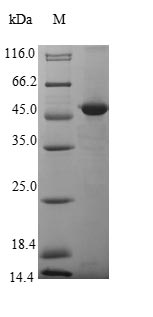This recombinant Mouse Egfl8 protein is typically achieved by the manipulation of Egfl8 gene expression in E.coli cells so that it expresses large amounts of a recombinant Egfl8 gene. In order to get enough amount of the Egfl8 protein, strain selection, codon optimization, fusion systems, co-expression, mutagenesis, and isotope labeling techniques are used. Finally, the Egfl8 protein is isolated from the samples such as cell lysates or medium. Protein refolding, cleavage of fusion moieties and chromatography techniques are involved in the protein purification process.
Egfl8 plays negative regulatory roles in mouse thymic epithelial cells (TECs) and thymocytes. It has shown that Egfl8 is downregulated in gastric cancer (GC) and is closely associated with high tumor-node-metastasis stage and dismal prognosis in gastric and colorectal cancer. In addition to participating in thymopoiesis, Egfl8 is also involved in cell migration and invasion by regulating Notch signaling. Egfl8 also can act as a neuritogen and rewire cellular signaling by activating kinases involved in neurogenesis.






